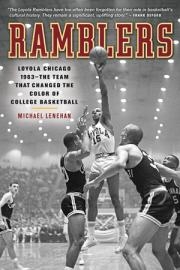
Ramblers: Loyola Chicago 1963-The Team that Changed the Color of College Basketball
by Michael Lenehan
Agate Midway
When the Loyola University Ramblers beat the Mississippi State Bulldogs 59-51 in an NCAA Division I men’s basketball game in December 2012, it was mostly ignored, even among rabid college basketball fans.
The game had been set up to commemorate a much more dramatic meeting of the two schools, who had last played in the 1963 NCAA tournament. At that time, the tournament hadn’t yet become March Madness, with the hoopla and betting frenzy marking today’s college basketball championships. That 1963 face-off is now known in basketball history as the Game of Change, a milestone in the movement for civil rights as well as in the evolution of the game of basketball.
In those days, even as the battle for civil rights raged and the integration of public schools moved rapidly forward, white players still dominated the college game, with African Americans mostly playing against one another on the teams of all-black colleges and universities. But that would change, as anyone who turns on their television during a college basketball game today can easily confirm. In 1962, according to the Journal of Sport Behavior, 45.2 percent of college teams had at least one black player, and virtually none of those schools were in the South. By 1975 the percentage had climbed to 92.4. What’s more, the average number of black players per team increased to 4.5 from 2.2.
The Ramblers, with an unprecedented four black players among the starting five, won that 1963 game against MSU, then went on to beat all comers, including number-two-ranked Duke in the semifinal game and, in the championship game, college hoops’ reigning powerhouse, the Cincinnati Bearcats, a team that also started three black players.
In his first book, Ramblers: Loyola Chicago 1963—The Team that Changed the Color of College Basketball, Michael Lenehan tells the story of how, in the process of becoming NCAA national champions, Loyola broke the mold not only of who played college basketball, but also of how the game was played.
Lenehan, known mostly for his many years as editor and executive editor of the Chicago Reader, builds his narrative around the final game, weaving together the myriad threads that made that year’s tournament a groundbreaking event. Using dozens of interviews with players, coaches, journalists, and others who helped build the modern-day game, and doing the kind of exhaustive research he has pushed writers towards in his role as editor, Lenehan has assembled a powerful account of what he calls a “milestone in a long, involved history” of “basketball’s integration and evolution.”
The success of Loyola’s team was a benchmark—the beginning of the end for segregation in college basketball. Finally, African American players would begin to gain full access, including scholarships, to the most prestigious universities. And along with that came the kind of exposure that would facilitate their entry into the ranks of the professional game, another place where white players had an unwarranted edge.
Loyola had opened the door. In 1966, all five starters from Texas Western College (now the University of Texas, El Paso) were black. The Miners became NCAA champions by beating the all-white Kentucky team in the final game.
One blogger went so far as to claim that the Texas Western coach, Don Haskins, “did more in this one game to further the cause of integration than Martin Luther King. This game was the defining Game of the Century for college basketball.” An exaggeration, to be sure, but there’s little question that the civil rights movement and the game of basketball have shared a symbiotic relationship.
Back to the Loyola Ramblers: They played a fast-paced game, honed on the playgrounds of the nation’s largest cities. It was a game unfamiliar to the most successful college coaches, who taught tight defense and a highly structured, patterned offense. In those days, Lenehan reminds us, the game was mostly played on the floor, while today’s game is played in the air.
Morris “Bucky” Buckwalter, a former NBA scout and coach who author David Halberstam credited with opening doors for black players, was one of Lenehan’s interviewees. “With the shot blocking and the rebounding and the high-flying dunks, it was no longer a horizontal game,” Buckwalter explains. “It had become vertical.”
“The game’s axis had just been tilted 90 degrees,” Lenehan marvels.
But the style of play wasn’t the only thing that was changing in college basketball. Lenehan tells of a 1960 Ramblers game played against Loyola University of New Orleans at a time when the Ramblers’ star player was 6ʹ5ʺ Clarence Red, a black player from Algiers, Louisiana: “Where Mississippi had an unwritten rule against integrated sporting events, Louisiana had it in writing—a state law enacted in 1956...That law had been successfully challenged in 1958, but no integrated sporting event took place in Louisiana until the two Jesuit schools contrived this battle of the Loyolas.” Loyola of New Orleans won.
And racial barriers in college basketball were beginning to break down elsewhere across the nation. In 1961 James Meredith decided he would become the first black student to enroll at the University of Mississippi. Governor Ross Barnett, whom Lenehan describes as an “unabashed racist,” promised the residents of the state, “No school will be integrated in Mississippi while I am your governor.” Eventually thirty thousand federal troops made Barnett eat his words. Lenehan maintains that Meredith’s struggle was crucial. “Because of what happened [at Ole Miss] . . . Mississippi State would finally get its chance to go to the NCAA tournament,” he writes, and go on to play Loyola in that 1963 Game of Change.
Despite Lenehan’s lack of experience in writing about basketball, Ramblers is an easy, fascinating, and at times illuminating read for the avid fan. The less knowledgeable, who will find it valuable as a crucial chapter in the history of the struggle for civil rights, can also gain a beginner's appreciation of the game’s finer points. It tugs at the reader’s heartstrings while providing a clear-eyed look at the sometimes shameful, sometimes constructive role of sports in our society.


